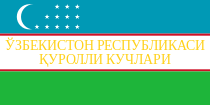Flag of Uzbekistan
 | |
| Template:Lang-uz | |
| Use | Civil and state flag, civil and state ensign |
|---|---|
| Proportion | 1:2 |
| Adopted | 18 November 1991 |
| Design | A horizontal blue, white and green stripes, separated by two narrow red stripes. A crescent and three rows of twelve stars are situated on the left side of the upper blue stripe. |
 | |
| Use | War flag |
| Proportion | 1:2 |
| Adopted | 4 June 1992 |
The flag of Uzbekistan (Template:Lang-uz, Template:Lang-ru) consists of three horizontal blue, white and green bands separated by two thin red fimbriations, with a crescent moon and twelve stars at the canton. Adopted in 1991 to replace the flag of the Uzbek Soviet Socialist Republic (SSR), it has been the flag of the Republic of Uzbekistan since the country gained independence in that same year. The design of the present flag was partly inspired by the former one.
History
Under Soviet rule, the Union Republic – situated in what is now modern-day Uzbekistan – utilized a flag derived from the flag of the Soviet Union and representing Communism, that was approved in 1952.[1] It declared itself independent on September 1, 1991, approximately three months before the dissolution of the Soviet Union.[2] A search for a national flag began soon after, with a contest being held to determine the new design.[1] More than 200 submissions were made, and a commission was formed in order to evaluate these suggestions coming from a variety of stakeholders.[3] The winning design was adopted on November 18, 1991,[1] after being selected at an extraordinary session of the Uzbek Supreme Soviet.[4][5] In doing so, Uzbekistan became the first of the newly-independent republics in Central Asia to choose a new flag.[6]
Design
Symbolism
The colors and symbols of the flag carry cultural, political, and regional meanings. The white stands for peace and purity, while blue represents water and the sky. The latter colour also alludes to the flag of Timur, who ruled over present-day Uzbekistan during the 14th century.[1][6] Green officially epitomizes "nature and fertility" – though it may also represent Islam[1] – while the thin red stripes represents the "life force" within everyone.[1][6] The crescent at the canton evokes "the rebirth of" Uzbekistan as an "independent" country.[1][7] Moreover, it symbolizes the Islamic faith practiced by 88% of Uzbekistan's population.[2] To the right of the crescent are twelve stars, which signify the months of the Islamic calendar,[6] as well as the constellations featured in the zodiac.[1]
Legal protection
On December 27, 2010, President Islam Karimov signed an amendment to the law that strengthened the protection of the country's symbols, including its flag and emblem. It banned the utilization of the flag of Uzbekistan for promotional and commercial purposes, including its usage in advertisements and documents. It also forbade any organizations that are not affiliated with the Uzbek government from adopting logos that resemble the national symbols.[8]
See also
References
- ^ a b c d e f g h Smith, Whitney. "Uzbekistan, flag of". Encyclopedia Britannica. Encyclopedia Britannica, Inc. Retrieved May 18, 2014. (subscription required)
- ^ a b "Uzbekistan". The World Factbook. CIA. Retrieved May 18, 2014.
- ^ "The National Flag of the Republic of Uzbekistan Celebrates 20th Anniversary". Journal of Turkish Weekly. International Strategic Research Organization. November 18, 2011. Retrieved May 18, 2014.
- ^ Azizov, D. (November 18, 2010). "Brief: Uzbekistan celebrates Flag Day". Baku, Azerbaijan: Trend News Agency. Retrieved May 18, 2014. (subscription required)
- ^ McCray, Thomas R.; Gritzner, Charles F. (January 1, 2009). Uzbekistan. Infobase Publishing. p. 96. Retrieved May 18, 2014.
- ^ a b c d Kindersley, Dorling (November 3, 2008). Complete Flags of the World. Dorling Kindersley Ltd. p. 191. Retrieved May 18, 2014.
- ^ Waters, Bella (2006). Uzbekistan in Pictures. Twenty-First Century Books. p. 191. Retrieved May 18, 2014.
- ^ Azizov, D. (December 27, 2010). "Brief: Uzbekistan bans using state symbols in commercial purposes". Baku, Azerbaijan: Trend News Agency. Retrieved May 18, 2014. (subscription required)

